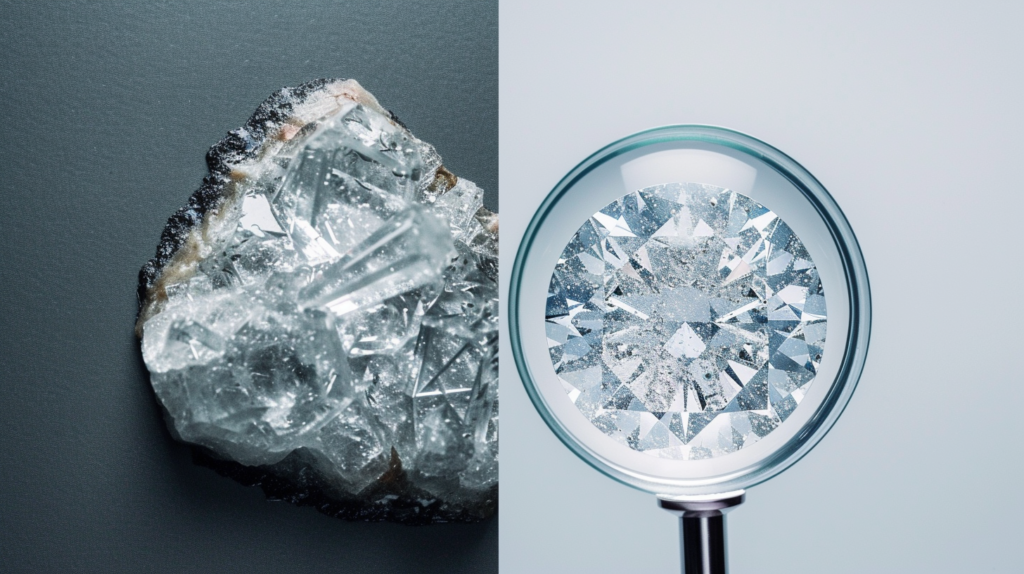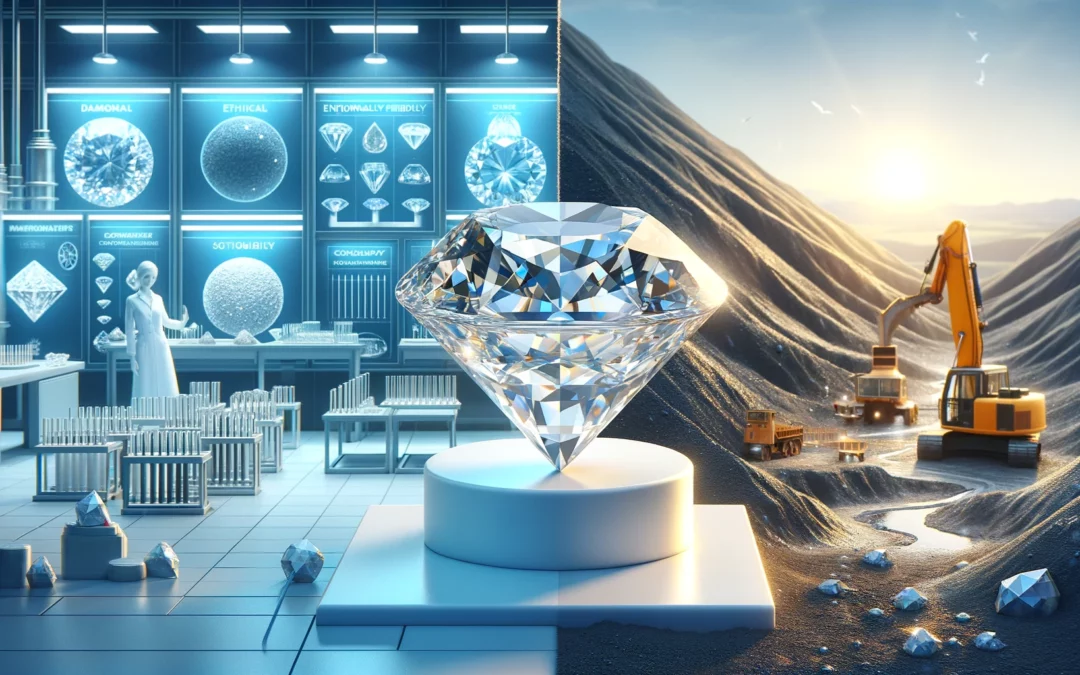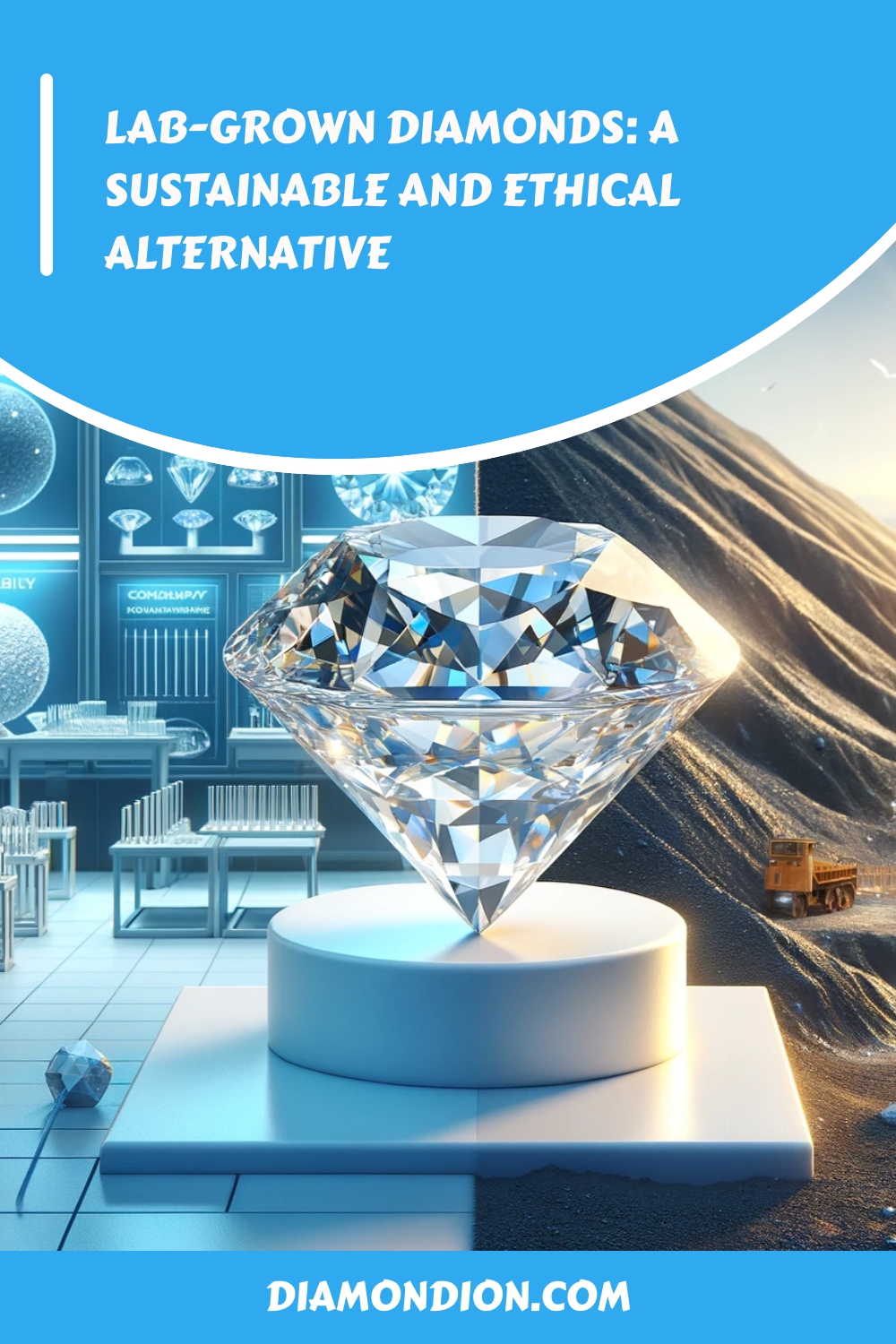Article Contents
- 1 What are Lab-grown Diamonds?
- 2 Creating Lab-Grown Diamonds
- 3 Advantages of Lab-Grown Diamonds
- 4 The Creation Process Of Lab Diamonds
- 5 Properties and Similarities Between Mined and Lab Diamonds
- 6 Sustainability and Ethics Of Lab Diamonds
- 7 Our Final Thoughts About Lab Diamonds: What Do You Think?
- 8 Are Lab-Grown Diamonds Truly a Sustainable and Ethical Alternative to Mined Diamonds?
- 9 Further Reading About Lab Diamonds
Lab-grown diamonds have become a controversial topic in the world of precious stones. While they are chemically and physically identical to natural diamonds, the debate arises when considering their rarity and natural formation. In this blog post, we will explore the process of creating lab-grown diamonds and discuss their benefits as a sustainable and ethical alternative to mined diamonds. Labgrown diamonds are created through a process called chemical vapor deposition (CVD) or high pressure, high temperature (HPHT). This method involves replicating the natural diamond-growing process in a controlled environment, resulting in diamonds that are virtually indistinguishable from those mined from the earth. Furthermore, labgrown diamonds have a lower environmental impact and do not contribute to the ethical concerns surrounding the diamond mining industry.
Yes, lab-grown diamonds are a sustainable and ethical alternative to mined diamonds. They are created in a controlled environment using advanced technology, which reduces the environmental impact and eliminates the ethical concerns associated with mining.
What are Lab-grown Diamonds?
Lab-grown diamonds have been gaining popularity in recent years as an alternative to natural diamonds. These diamonds are created in a controlled environment where scientists replicate the natural process of diamond formation. By using high pressure and high temperature (HPHT) or chemical vapour deposition (CVD) techniques, they can grow chemically and physically identical to natural diamonds.
Creating Lab-Grown Diamonds
The process of creating lab-grown diamonds begins with a small diamond seed placed in a chamber with a carbon-rich gas. In the case of HPHT, the chamber is then exposed to extremely high pressure and temperature, causing the carbon atoms to crystallize and form a diamond. On the other hand, CVD involves heating a hydrocarbon gas to produce plasma, which breaks down and deposits carbon atoms onto the diamond seed, gradually growing the diamond layer by layer.
Both methods require precise control of the growth parameters to ensure the formation of high-quality diamonds. The duration of the process can vary depending on the desired size and quality of the diamond, ranging from a few weeks to several months.

Advantages of Lab-Grown Diamonds
Lab-grown diamonds offer several advantages over their natural counterparts.
- Environmentally Friendly: The process of mining natural diamonds has a significant impact on the environment, causing deforestation, soil erosion, and pollution. Lab-grown diamonds, on the other hand, have a much lower carbon footprint and eliminate the need for mining.
- Ethical Sourcing: The diamond industry has faced controversies regarding the ethical sourcing of diamonds, particularly concerning human rights abuses and conflict diamonds. Lab-grown diamonds provide a transparent and ethical alternative, as they are not associated with these issues.
- Cost-effective: Lab-grown diamonds are typically more affordable compared to natural diamonds of the same quality. This makes them a popular choice for individuals who are looking for a budget-friendly option without compromising on the brilliance and beauty of a diamond.
- Consistency: One of the notable advantages of lab-grown diamonds is their consistency in terms of colour and clarity. Natural diamonds can have variations and inclusions, while lab-grown diamonds can be produced with specific characteristics and qualities, providing a more predictable outcome.
- Endless Possibilities: Lab-grown diamonds offer endless possibilities in terms of customization. Their growth process allows for the creation of fancy-coloured diamonds, which are much rarer and more expensive in their natural form.
Lab-grown diamonds are revolutionizing the diamond industry by providing a sustainable and ethical alternative to natural diamonds. Whether it’s for engagement rings, jewellery, or investment purposes, lab-grown diamonds offer a remarkable option that combines beauty, affordability, and peace of mind.
The Creation Process Of Lab Diamonds
Lab-grown diamonds are revolutionizing the jewellery industry, providing an ethical and sustainable alternative to mined diamonds. These diamonds are visually identical to natural diamonds and are created using advanced technology in a controlled environment. The journey of a lab-grown diamond starts with the creation process, which involves the use of a diamond seed and extreme heat and pressure.
The Diamond Seed
At the heart of the creation process lies the diamond seed, which serves as the foundation for the growth of the lab-grown diamond. This seed is typically a tiny piece of natural diamond or synthetic diamond, carefully selected for its quality and purity. The diamond seed acts as a template for the crystal lattice structure of the lab-grown diamond to form.
Extreme Heat and Pressure
The diamond seed is placed in a chamber with extreme heat and pressure. This chamber replicates the conditions found deep within the earth, where natural diamonds are formed. The temperature inside the chamber can reach up to 2,500 degrees Celsius, while the pressure can exceed 5 GigaPascals.
Under such intense conditions, the carbon atoms in the chamber start to bond and form a diamond crystal around the diamond seed. Layer by layer, the diamond seed grows as more carbon atoms join the crystal lattice. This process is known as Chemical Vapor Deposition (CVD) or the High Pressure-High Temperature (HPHT) method, depending on the specific technique used.
The Growth Process
The growth of a lab-grown diamond takes time and precision. The diamond seed can take several weeks to grow into a fully-fledged diamond, with each layer adding to its size and quality. The process is monitored consistently to ensure optimal conditions for diamond growth and to prevent any impurities or defects from forming.
As the diamond seed grows layer by layer, it undergoes meticulous quality checks to ensure its visual and chemical properties match those of a natural diamond. After that, skilled craftsmen carefully cut and polished the lab-grown diamond to bring out its brilliance and beauty.
By using advanced technology and replicating the conditions present deep within the Earth, lab-grown diamonds offer a sustainable and environmentally friendly alternative to mined diamonds. They provide the same stunning beauty and durability while avoiding the ethical concerns associated with diamond mining. The creation process of lab-grown diamonds showcases the amazing capabilities of science and innovation in producing exquisite gemstones. Labgrown diamonds also have the potential to disrupt the traditional diamond industry by offering a more affordable option without sacrificing quality. With advancements in technology, lab-grown diamonds are becoming increasingly indistinguishable from natural diamonds, making them a popular choice for consumers seeking an ethical and sustainable alternative. As the demand for lab-grown diamonds continues to rise, they are poised to revolutionize the way we think about and purchase these timeless gemstones. Labgrown diamonds are also a more transparent option, as their origin and production process can be easily traced and verified. This transparency provides consumers with peace of mind, knowing the exact history of their diamond and supporting a more ethical and sustainable industry. With their positive impact on the environment and ethical considerations, labgrown diamonds are positioned to become the preferred choice for conscientious consumers.
Properties and Similarities Between Mined and Lab Diamonds
When it comes to lab-grown diamonds, many people are curious about how they compare to natural diamonds. In terms of their properties and similarities, lab-grown diamonds are virtually identical to their natural counterparts.
Physical Properties
Lab-grown diamonds have the same physical properties as natural diamonds. They are composed of carbon atoms arranged in a crystal lattice structure. This gives them their renowned hardness, making them one of the hardest materials on Earth. Lab-grown diamonds also have the same density, refractive index, and thermal conductivity as natural diamonds.
Chemical Properties
Chemically, lab-grown diamonds are indistinguishable from natural diamonds. Both types of diamonds are made entirely of carbon, with no trace elements or impurities. This means that lab-grown diamonds exhibit the same chemical reactions and behaviours as natural diamonds when exposed to various environments and tests.
Optical Properties
The optical properties of lab-grown diamonds are another area where they mirror natural diamonds. Lab-grown diamonds have the same brilliance, fire, and scintillation as their natural counterparts. They are cut and polished using the same techniques and possess the same ability to reflect and refract light, creating stunning displays of sparkle and shine.
Under a microscope, it is virtually impossible to distinguish between lab-grown and natural diamonds. They share the same crystal structure and exhibit the same physical and optical properties, making it challenging, if not impossible, to differentiate the two without specialized equipment or expert knowledge.
It is important to note that while lab-grown diamonds are physically and chemically identical to natural diamonds, they are created in a controlled environment rather than through millions of years of natural geological processes. This difference in origin does not diminish their value or quality; it simply offers a more sustainable and ethically sourced alternative to mined diamonds.
In conclusion, lab-grown diamonds possess the same physical, chemical, and optical properties as natural diamonds. Their similarities extend to their crystal structure, hardness, density, refractive index, brilliance, and overall appearance. Whether you choose a lab-grown diamond or a natural diamond, you can be confident that both types possess the extraordinary beauty and durability that diamonds are renowned for.
Sustainability and Ethics Of Lab Diamonds
Lab diamonds offer a more sustainable and ethical alternative to mined diamonds. Unlike traditional diamonds, lab-grown diamonds do not require extensive mining operations that harm the environment and exploit workers.
Sustainability of Lab-Grown Diamonds
One of the key advantages of lab-grown diamonds is their reduced environmental impact. Mined diamonds involve extensive excavation, land disruption, and the use of heavy machinery. This causes deforestation and habitat destruction and contributes to land degradation and water pollution.
In contrast, lab-grown diamonds are created in controlled laboratory environments using advanced technology. The process involves replicating the same high-pressure and high-temperature conditions that occur naturally beneath the Earth’s surface, allowing diamond crystals to form over time. This eliminates the need for extensive mining and minimizes the ecological footprint associated with diamond production.
Furthermore, the production of lab-grown diamonds requires significantly less energy compared to mining and processing natural diamonds. This makes them a more energy-efficient choice and contributes to a reduced carbon footprint.
Ethics of Lab-Grown Diamonds
In addition to sustainability, lab-grown diamonds also address ethical concerns within the diamond industry. Mined diamonds are often associated with human rights abuses, including forced labour, child labour, and poor working conditions.
On the other hand, lab-grown diamonds are produced in a controlled laboratory environment, ensuring workers’ safety and fair treatment. The production process adheres to strict labour standards, providing a more responsible and ethical alternative to traditional diamond mining.
By choosing lab-grown diamonds, consumers can have peace of mind knowing that they are supporting a more sustainable and ethical diamond industry. These diamonds offer the same physical and chemical properties as natural diamonds, making them indistinguishable to the average consumer.
Ultimately, lab-grown diamonds represent a positive shift in the diamond industry. They reduce the environmental impact of diamond production and promote fair labour practices. As more consumers become aware of the benefits of lab-grown diamonds, the demand for sustainable and ethically sourced diamonds is expected to increase.
Choosing lab-grown diamonds is a beautiful choice and a responsible one.
Our Final Thoughts About Lab Diamonds: What Do You Think?
Lab-grown diamonds have emerged as a viable and scientifically supported alternative to natural diamonds. With advancements in technology and research, these diamonds are now being created in controlled laboratory settings using high-tech equipment.
One of the key benefits of lab-grown diamonds is their ethical and sustainable nature. Traditional diamond mining has been plagued with issues such as environmental destruction, human rights abuses, and conflict financing. Lab-grown diamonds, on the other hand, are created without such negative impacts. They offer a responsible choice for consumers concerned about their jewellery’s origins and impact.
Furthermore, lab-grown diamonds possess the same physical, chemical, and optical properties as natural diamonds. They are composed of carbon atoms arranged in a crystal lattice structure, making them visually indistinguishable from their natural counterparts. In fact, only trained gemologists with specialized equipment can discern between a lab-grown diamond and a natural diamond.
Another advantage of lab-grown diamonds is their affordability. Traditional diamonds are inherently rare, and factors like rarity, mining costs, and market demand greatly impact their prices. Lab-grown diamonds, on the other hand, can be produced in larger quantities and at a more consistent quality. This results in a lower production cost, which is then passed on to consumers. As a result, lab-grown diamonds are typically priced 30–40% less than natural diamonds.
In addition to their ethical and affordable nature, lab-grown diamonds also offer customization options. Through the use of advanced technologies, they can be tailored to meet specific requirements in terms of size, colour, and clarity. This customisation level allows customers to create unique and personalized jewellery pieces according to their preferences.
Are Lab-Grown Diamonds Truly a Sustainable and Ethical Alternative to Mined Diamonds?
Lab-grown diamonds are gaining attention as a sustainable and ethical alternative to mined diamonds, offering a solution to the environmental and social challenges of traditional mining. With significantly lower carbon footprints and no association with conflict zones, labgrown diamonds present a modern, eco-conscious choice for those seeking luxury without compromise.
Further Reading About Lab Diamonds
1: https://4cs.gia.edu/en-us/laboratory-grown-diamond/
2: https://www.brides.com/lab-grown-diamonds-guide-7550087
3: https://www.ritani.com/blogs/education/how-are-lab-grown-diamonds-made
4: https://www.afterdiamonds.co.uk/a/blog/can-diamonds-made-in-a-lab-replace-natural-ones
5: https://www.gemsociety.org/article/are-diamonds-really-rare/



